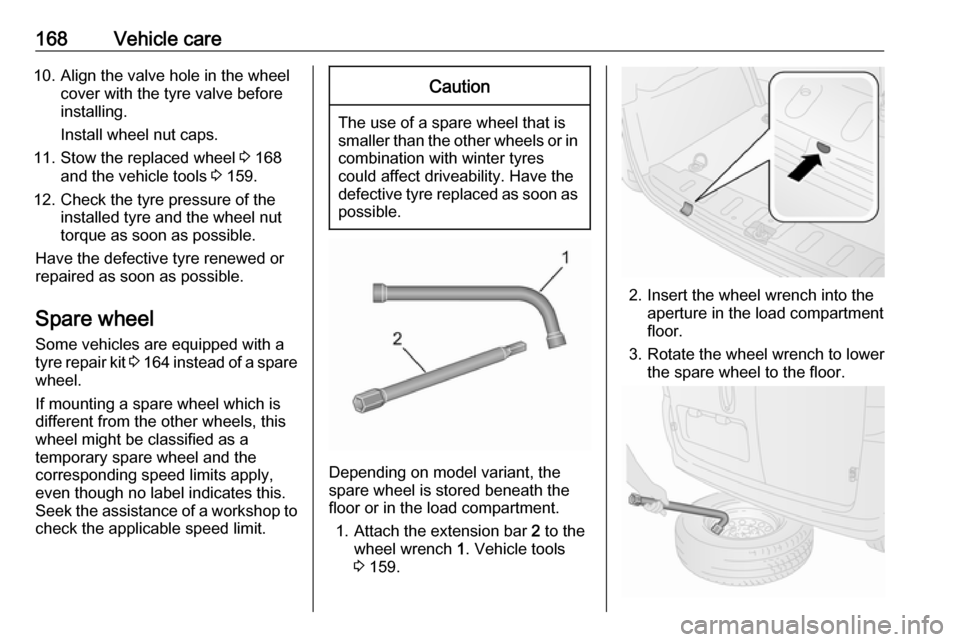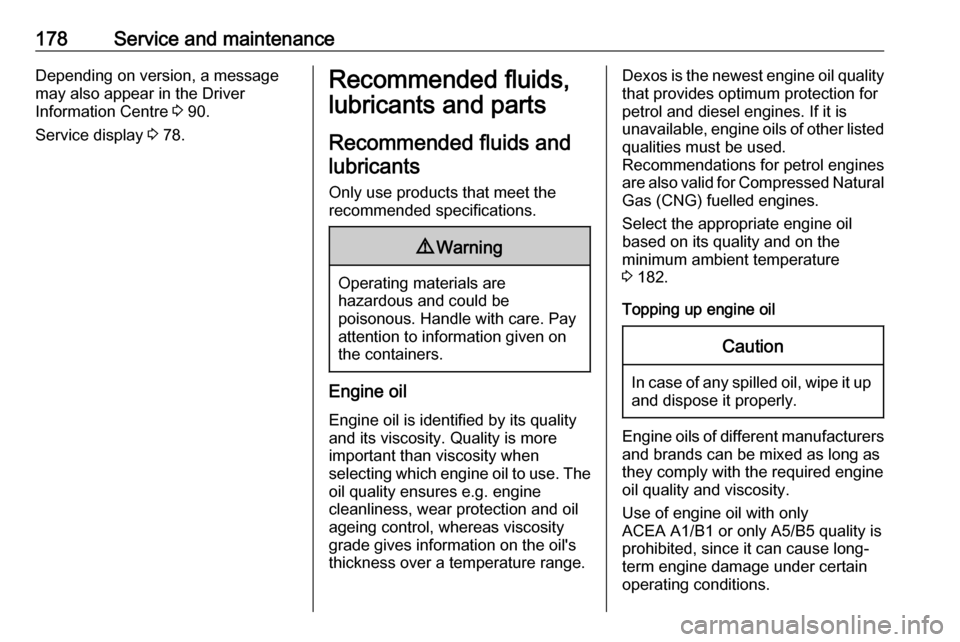Temp VAUXHALL COMBO D 2018 Service Manual
[x] Cancel search | Manufacturer: VAUXHALL, Model Year: 2018, Model line: COMBO D, Model: VAUXHALL COMBO D 2018Pages: 203, PDF Size: 4.76 MB
Page 163 of 203

Vehicle care1619Warning
For specific tyres the
recommended tyre pressure as
shown in the tyre pressure table may exceed the maximum tyre
pressure as indicated on the tyre.
Never exceed the maximum tyre
pressure as indicated on the tyre.
If the tyre pressure must be reduced
or increased on a vehicle with tyre
pressure monitoring system, switch
off ignition.
Temperature dependency
The tyre pressure depends on the
temperature of the tyre. During
driving, tyre temperature and
pressure increase. Tyre pressure
values provided on the tyre
information label and tyre pressure
chart are valid for cold tyres, which means at 20 °C.
The pressure increases by nearly
1.5 psi for a 10 °C temperature
increase. This must be considered
when warm tyres are checked.
Tyre pressure monitoring
system
The tyre pressure monitoring system
uses radio and sensor technology to
check tyre pressure levels.Caution
Tyre pressure monitoring system
warns only about low tyre pressure condition and does not replace
regular tyre maintenance by the
driver.
The tyre pressure monitoring system sensors monitor the air pressure in
the tyres and transmit tyre pressure
readings to a receiver located in the
vehicle.
All wheels must be equipped with
pressure sensors and the tyres must
have the prescribed pressure.
Tyre pressure chart 3 191.
Notice
In countries where the tyre pressure
monitoring system is legally
required, the use of wheels without
pressure sensors will invalidate the
vehicle operating permit.
Low tyre pressure condition
A detected low tyre pressure
condition is indicated by illumination
of control indicator w 3 87 together
with a warning chime. In vehicles with Multifunction version of the Driver
Information Centre, a corresponding message is also displayed.
Page 164 of 203

162Vehicle careIf w illuminates, stop as soon as
possible and inflate the tyres as
recommended 3 191.
After inflating, driving may be
required to update the tyre pressure
values in the system. During this time
w may illuminate.
If w illuminates at lower temperatures
and extinguishes after some driving,
this could be an indicator for
approaching a low tyre pressure
condition. Check tyre pressure of all
four tyres.
If the tyre pressure must be reduced
or increased, switch off ignition.
Only mount wheels with pressure
sensors, otherwise the tyre pressure
value cannot be recognised by the
system and w flashes for several
seconds then illuminates
continuously. In vehicles with
Multifunction version of the Driver
Information Centre, a corresponding message is also displayed.
A spare wheel or temporary spare
wheel is not equipped with pressure
sensors. The tyre pressure
monitoring system is not operationalfor these wheels. For the further three
wheels, tyre pressure monitoring
system remains operational.
Spare wheel 3 168, Wheel changing
3 166.
Control indicator w and (depending
on version) a corresponding message appears at each ignition cycle until
the tyres are inflated to the correct
tyre pressure.
Driver Information Centre 3 90.
Relearn function
After changing wheels, the tyre
pressure monitoring system needs to
recalculate. The relearn process
takes up to 20 minutes of driving with
a minimum speed of 12 mph.
If problems occur during the relearn
process, control indicator w flashes
for several seconds then illuminates
continuously and (depending on
version) a warning message is
displayed in the Driver Information
Centre.
Driver Information Centre 3 90.General information
The use of tyre chains or
commercially available liquid tyre
repair kits can impair the function of
the system. Factory-approved tyre
repair kits can be used.
Tyre repair kit 3 164.
Tyre chains 3 163.
Operating electronic devices or being
close to facilities using similar wave
frequencies could disrupt the tyre
pressure monitoring system.
Each time the tyres are replaced, tyre pressure monitoring system sensors
must be dismounted and serviced by
a workshop.
Tread depth
Check tread depth at regular
intervals.
Tyres should be replaced for safety
reasons at a tread depth of 2-3 mm
(4 mm for winter tyres).
For safety reasons, it is
recommended that the tread depth of the tyres on one axle should not vary
by more than 2 mm.
Page 170 of 203

168Vehicle care10. Align the valve hole in the wheelcover with the tyre valve before
installing.
Install wheel nut caps.
11. Stow the replaced wheel 3 168
and the vehicle tools 3 159.
12. Check the tyre pressure of the installed tyre and the wheel nut
torque as soon as possible.
Have the defective tyre renewed or
repaired as soon as possible.
Spare wheel
Some vehicles are equipped with a tyre repair kit 3 164 instead of a spare
wheel.
If mounting a spare wheel which is
different from the other wheels, this
wheel might be classified as a
temporary spare wheel and the
corresponding speed limits apply,
even though no label indicates this.
Seek the assistance of a workshop to
check the applicable speed limit.Caution
The use of a spare wheel that is smaller than the other wheels or in combination with winter tyres
could affect driveability. Have the defective tyre replaced as soon as
possible.
Depending on model variant, the
spare wheel is stored beneath the
floor or in the load compartment.
1. Attach the extension bar 2 to the
wheel wrench 1. Vehicle tools
3 159.
2. Insert the wheel wrench into the
aperture in the load compartment
floor.
3. Rotate the wheel wrench to lower the spare wheel to the floor.
Page 172 of 203

170Vehicle care3.Position the replaced spare wheel
onto the bracket ensuring correct
alignment of the locating pin.
4. Secure spare wheel by tightening two bolts using the wheel wrench.
Have the defective tyre renewed or
repaired as soon as possible.
Directional tyres
If possible, fit directional tyres such
that they roll in the direction of travel.
The rolling direction is indicated by a
symbol (e.g. an arrow) on the
sidewall.
The following applies to tyres fitted
opposing the rolling direction:
● Driveability may be affected. Have the defective tyre renewed
or repaired as soon as possible
and fit it instead of the spare
wheel.
● Drive particularly carefully on wet
and snow-covered road
surfaces.Jump starting
Do not start with quick charger.
A vehicle with a discharged battery
can be started using jump leads and
the battery of another vehicle.9 Warning
Be extremely careful when starting
with jump leads. Any deviation
from the following instructions can
lead to injuries or damage caused
by battery explosion or damage to the electrical systems of both
vehicles.
9 Warning
Avoid contact of the vehicle
battery with eyes, skin, fabrics and painted surfaces. The fluid
contains sulphuric acid which can
cause injuries and damage in the
event of direct contact.
● Never expose the vehicle battery
to naked flames or sparks.
● A discharged vehicle battery can already freeze at a temperature
of 0 °C. Defrost the frozen battery
before connecting jump leads.
● Wear eye protection and protective clothing when
handling a vehicle battery.
● Use a booster battery with the same voltage (12 V). Its capacity
(Ah) must not be much less than
that of the discharged vehicle
battery.
● Use jump leads with insulated terminals and a cross section of
at least 16 mm 2
(25 mm 2
for
diesel engines).
● Do not disconnect the discharged
battery from the vehicle.
● Switch off all unnecessary electrical consumers.
● Do not lean over the vehicle battery during jump starting.
● Do not allow the terminals of one
lead to touch those of the other
lead.
Page 173 of 203

Vehicle care171● The vehicles must not come intocontact with each other during
the jump starting process.
● Apply the parking brake, transmission in neutral.
Lead connection order:
1. Connect the red lead to the positive terminal of the booster
battery.
2. Connect the other end of the red lead to the positive terminal of the
discharged vehicle battery.
3. Connect the black lead to the negative terminal of the booster
battery.
4. Connect the other end of the black
lead to a vehicle grounding point,
such as the engine block or an
engine mounting bolt. Connect as far away from the discharged
vehicle battery as possible,
however at least 60 cm.
Route the leads so that they cannot
catch on rotating parts in the engine
compartment.
To start the engine: 1. Start the engine of the vehicle providing the jump.
2. After five minutes, start the other engine. Start attempts should be
made for no longer than
15 seconds at an interval of
one minute.
3. Allow both engines to idle for approx. three minutes with the
leads connected.4. Switch on electrical consumers (e.g. headlights, heated rear
window) of the vehicle receiving
the jump start.
5. Reverse above sequence exactly when removing leads.
Page 180 of 203

178Service and maintenanceDepending on version, a message
may also appear in the Driver
Information Centre 3 90.
Service display 3 78.Recommended fluids,
lubricants and parts
Recommended fluids andlubricants
Only use products that meet the
recommended specifications.9 Warning
Operating materials are
hazardous and could be
poisonous. Handle with care. Pay
attention to information given on
the containers.
Engine oil
Engine oil is identified by its quality
and its viscosity. Quality is more
important than viscosity when
selecting which engine oil to use. The oil quality ensures e.g. engine
cleanliness, wear protection and oil
ageing control, whereas viscosity
grade gives information on the oil's
thickness over a temperature range.
Dexos is the newest engine oil quality
that provides optimum protection for
petrol and diesel engines. If it is
unavailable, engine oils of other listed qualities must be used.
Recommendations for petrol engines
are also valid for Compressed Natural
Gas (CNG) fuelled engines.
Select the appropriate engine oil
based on its quality and on the
minimum ambient temperature
3 182.
Topping up engine oilCaution
In case of any spilled oil, wipe it up and dispose it properly.
Engine oils of different manufacturersand brands can be mixed as long as
they comply with the required engine
oil quality and viscosity.
Use of engine oil with only
ACEA A1/B1 or only A5/B5 quality is
prohibited, since it can cause long-
term engine damage under certain
operating conditions.
Page 181 of 203

Service and maintenance179Select the appropriate engine oil
based on its quality and on the
minimum ambient temperature
3 182.
Additional engine oil additives
The use of additional engine oil
additives could cause damage and
invalidate the warranty.
Engine oil viscosity
The SAE viscosity grade gives
information on the thickness of the oil.
Multigrade oil is indicated by two
figures, e.g. SAE 5W-30. The first
figure, followed by a W, indicates the
low temperature viscosity and the
second figure the high temperature viscosity.
Select the appropriate viscosity grade depending on the minimum ambient
temperature 3 182.
All of the recommended viscosity
grades are suitable for high ambient
temperatures.
Coolant and antifreeze
Use only antifreeze approved for the
vehicle. Consult a workshop.The system is factory filled with
coolant designed for excellent
corrosion protection and frost
protection down to approx. -28 °C. In
regions with very low temperatures,
the factory filled coolant provides frost
protection down to approx. -37 °C.
This concentration should be
maintained all year round.
The use of additional coolant
additives that intend to give additional
corrosion protection or seal against
minor leaks can cause function
problems. Liability for consequences
resulting from the use of additional
coolant additives will be rejected.
Washer fluid
Use only washer fluid approved for
the vehicle to prevent damage of wiper blades, paintwork, plastic and
rubber parts. Consult a workshop.
Brake and clutch fluidOver time, brake fluid absorbs
moisture which will reduce braking
effectiveness. The brake fluid should
therefore be replaced at the specified
interval.
Page 184 of 203

182Technical dataVehicle dataRecommended fluids andlubricants
Required engine oil qualityEngine oil quality: Europedexos 2✔
For countries with International
service interval 3 177, you may use
the oil qualities listed below:
Engine oil quality: Internationaldexos 2✔ACEA C3✔ACEA A3/B4✔Engine oil viscosity gradesAmbient temperaturedown to
-25 °CSAE 0W-30 or
SAE 0W-40
SAE 5W-30 or
SAE 5W-40below
-25 °CSAE 0W-30 or
SAE 0W-40
Page 196 of 203

194Customer informationVehicle data recording
and privacy
Event data recorders Data storage modules in the
vehicle
A large number of electronic
components of your vehicle contain
data storage modules temporarily or
permanently storing technical data
about the condition of the vehicle,
events and errors. In general, this
technical information documents the
condition of parts, modules, systems
or the environment:
● operating conditions of system components (e.g. filling levels)
● status messages of the vehicle and its single components (e.g.
number of wheel revolutions / rotational speed, deceleration,
lateral acceleration)
● dysfunctions and defects in important system components● vehicle reactions in particulardriving situations (e.g. inflation of
an airbag, activation of the
stability regulation system)
● environmental conditions (e.g. temperature)
This data is exclusively technical and
helps identifying and correcting errors as well as optimizing vehicle
functions.
Motion profiles indicating travelled
routes cannot be created with this
data.
If services are used (e.g. repair
works, service processes, warranty
cases, quality assurance),
employees of the service network
(manufacturer included) are able to
read out this technical information
from the event and error data storage
modules applying special diagnostic
devices. If required, you will receive
further information at these
workshops. After an error has been
corrected, the data is deleted from the
error storage module or it is
constantly overwritten.When using the vehicle, situations
may occur in which technical data
related to other information (accident
report, damages on the vehicle,
witness statements etc.) may be
associated with a specific person -
possibly, with the assistance of an
expert.
Additional functions contractually
agreed upon with the client (e.g.
vehicle location in emergency cases)
allow the transmission of particular
vehicle data from the vehicle.
Radio Frequency
Identification (RFID)
RFID technology is used in some
vehicles for functions such as tyre
pressure monitoring and ignition
system security. It is also used in
connection with conveniences such
as radio remote controls for door
locking/unlocking and starting, and in- vehicle transmitters for garage dooropeners. RFID technology in
Vauxhall vehicles does not use or
record personal information or link
with any other Vauxhall system
containing personal information.
Page 199 of 203

197Chimes......................................... 95
Cigarette lighter ........................... 75
Climate control ............................. 15
Climate control systems .............106
Clock....................................... 72, 90
CNG.............................. 77, 135, 190
Collision damage repair ..............193
Control indicators.......................... 79
Control of the vehicle .................113
Controls ........................................ 70
Convex shape .............................. 29
Coolant and antifreeze ...............178
Cruise control ...................... 90, 130
Cupholders .................................. 61
D
Danger, Warnings and Cautions ...4
Date .............................................. 90
Daytime running lights ..........90, 100
Declaration of conformity ............192
Diesel particle filter ...............86, 120
Distance to next service ...............90
Door open .................................... 90
Doors ...................................... 25, 27
Drain fuel filter ............................. 89
Driver assistance systems ..........130
Driver Information Centre .............90
Driving characteristics and towing tips .............................. 138
Driving hints ................................ 113E
Eco mode (E).............................. 124
Electric adjustment ......................29
Electrical system......................... 155
Electronic climate control system 108
Electronic driving programmes ..124
Electronic Stability Control ..85, 129
Electronic Stability Control (ESC). 85
End-of-life vehicle recovery .......141
Engine compartment fuse box ...156
Engine coolant ........................... 144
Engine coolant temperature ........86
Engine coolant temperature gauge ....................................... 78
Engine data ............................... 183
Engine exhaust .......................... 120
Engine identification ...................181
Engine oil ...........143, 178, 182, 190
Engine oil pressure ......................87
ESC (Electronic Stability Control) 129
Event data recorders ..................194
Exit lighting ................................ 105
Extendable load compartment cover ................................... 63, 67
Exterior care .............................. 173
Exterior light ................................. 89
Exterior lighting ......................12, 99
Exterior mirrors ............................. 29F
Fault ........................................... 125
Fixed air vents ........................... 111
Fog light ....................................... 90
Fog lights ................................... 151
Folding front passenger seat ........37
Folding mirrors ............................. 30
Folding seats .......................... 40, 41
Front airbag system .....................51
Front fog lights ........................... 101
Front passenger seat Folding ...................................... 37
Table position ............................ 37
Front seats.................................... 35
Front storage ................................ 61
Front turn signal light ..................149
Fuel............................................. 134
Fuel consumption .........................90
Fuel consumption - CO 2-
Emissions ............................... 137
Fuel cut-off system .........81, 96, 115
Fuel for diesel engines ..............134
Fuel for natural gas operation ...135
Fuel for petrol engines ...............134
Fuel gauge ................................... 77
Fuel selector ................................ 77
Fuel system messages .........96, 115
Fuel tank ..................................... 190
Fuses ......................................... 155